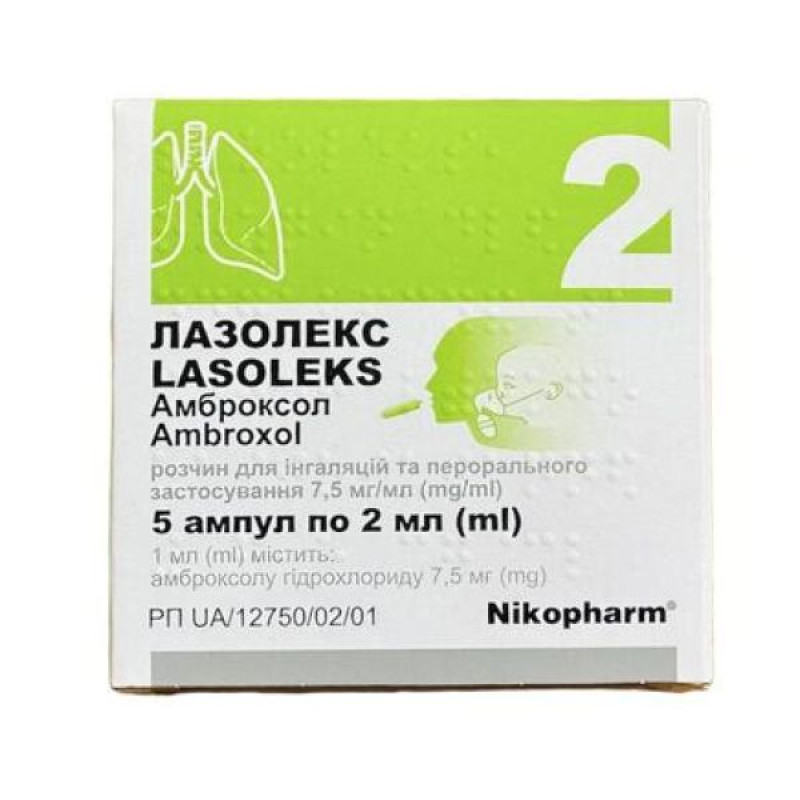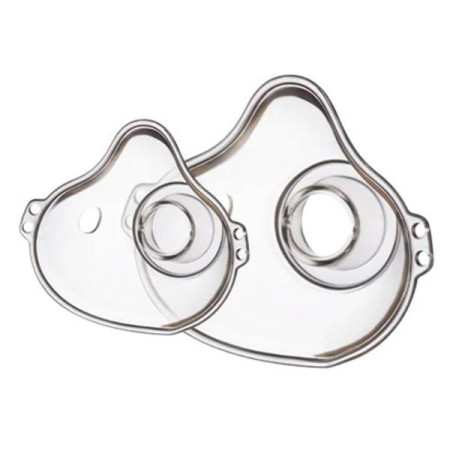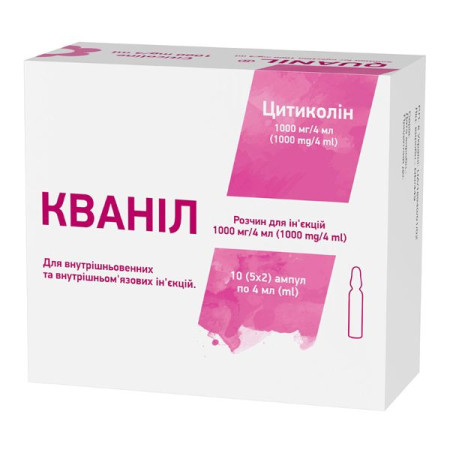Lazoleks solution for inhalation and oral administration 7.5 mg/ml ampoules 2 ml No. 5

Instructions for use Lazoleks solution for inhalation and oral administration 7.5 mg/ml ampoules 2 ml No. 5
Composition
active ingredient: ambroxol hydrochloride;
1 ml of solution contains 7.5 mg of ambroxol hydrochloride;
Excipients: sodium chloride, citric acid monohydrate (E 330), disodium phosphate dodecahydrate (E 339), water for injections.
Dosage form
Solution for injection.
Main physicochemical properties: colorless or yellowish transparent liquid.
Pharmacotherapeutic group
Medicines used for coughs and colds. Mucolytics. ATX code R05C B06.
Pharmacological properties
Pharmacodynamics
Preclinical studies have shown that ambroxol hydrochloride, the active ingredient of Lazolex, increases secretion in the respiratory tract. It also increases the secretion of pulmonary surfactant and stimulates the activity of the ciliary epithelium. These actions lead to improved mucus secretion and its elimination (mucociliary clearance). Improved mucociliary clearance has been demonstrated in clinical pharmacological studies. Activation of fluid secretion and increased mucociliary clearance contribute to the elimination of mucus and relieve cough.
In vitro studies have demonstrated that under the influence of ambroxol hydrochloride, the number of cytokinins decreases, as well as the number of circulating and tissue-associated mononuclear and polymorphonuclear cells.
Antioxidant effects of ambroxol have also been observed in many preclinical studies.
After the use of ambroxol hydrochloride, the concentration of antibiotics (amoxicillin, cefuroxime, erythromycin) in bronchopulmonary secretions and sputum increases.
Pharmacokinetics
Ambroxol hydrochloride is approximately 90% bound to plasma proteins in adults and 60-70% in neonates. The drug crosses the placental barrier and reaches the fetal lungs. The high volume of distribution (410 l) indicates greater tissue accumulation than plasma, with lung tissue concentrations exceeding plasma concentrations by a factor of ≥ 17.
Metabolism and excretion. Ambroxol hydrochloride is metabolized mainly in the liver by glucuronidation and to a lesser extent by cleavage to dibromanthranilic acid (the latter accounts for approximately 10% of the dose); other minor metabolites are also formed. Studies of human liver microsomes have shown that the enzyme CYP3A4 is responsible for the metabolism of ambroxol hydrochloride to dibromanthranilic acid. 3 days after intravenous administration, 4.6% of the dose is excreted unchanged, while 35.6% of the dose is excreted in the urine as conjugates.
The half-life of ambroxol hydrochloride from blood plasma is approximately 10 hours.
In neonates, after repeated intravenous administration, the half-life increases approximately twofold, indicating a decrease in clearance.
In severe liver disease, ambroxol clearance is reduced by 20-40%. In severe renal impairment, accumulation of ambroxol metabolites, namely dibromantranilic acid and glucuronides, is possible.
Ambroxol penetrates the blood-brain and placental barriers and is excreted in breast milk.
Indication
To enhance pulmonary surfactant production in premature infants and newborns with respiratory distress syndrome.
Contraindication
Known hypersensitivity to ambroxol hydrochloride or to any of the other components of the drug.
Special safety precautions
There have been a few reports of severe skin reactions: Stevens-Johnson syndrome and toxic epidermal necrolysis (Lyell's syndrome) associated with the use of expectorants such as ambroxol hydrochloride. Most of these could be explained by the severity of the underlying disease of the patients or the concomitant use of another drug. Therefore, if new skin or mucous membrane lesions appear, medical advice should be sought immediately and treatment with ambroxol hydrochloride should be discontinued.
Since ambroxol may increase mucus secretion, Lazolex, solution for injection, should be used with caution in cases of impaired bronchial motility and increased mucus secretion (for example, in a rare disease such as primary ciliary dyskinesia).
Lazolex, solution for injection, should be used with caution in patients with impaired renal function or severe liver disease (i.e. the interval between administrations should be increased or the dose should be reduced).
Accumulation of metabolites formed in the liver is expected in patients with severe renal impairment.
Interaction with other medicinal products and other types of interactions
To date, no clinically significant interactions of the drug with other drugs have been identified.
Simultaneous administration with antibiotics (amoxicillin, doxycycline, cefuroxime, erythromycin) leads to an increase in their concentration in the lung tissue.
Application features
If intravenous administration is carried out too quickly, in very rare cases headache, increased fatigue, exhaustion and a feeling of heaviness in the legs may occur.
Since ambroxol may increase mucus secretion, Lazoleks, solution for injection, should be used with caution in cases of impaired bronchial motility and increased mucus secretion (for example, in a rare disease such as primary ciliary dyskinesia).
Lazoleks should be used with caution in patients with impaired renal function or severe liver disease. When using ambroxol, as with any active substance that is metabolized in the liver and then excreted by the kidneys, accumulation of metabolites formed in the liver has been observed in patients with severe renal insufficiency.
Very rarely, severe skin reactions such as Stevens-Johnson syndrome or Lyell's syndrome (toxic epidermal necrolysis (TEN)) have sometimes occurred with the use of ambroxol. Most of these cases are associated with the underlying disease or with the simultaneous use of another drug. If any changes occur on the skin or mucous membranes, ambroxol should be discontinued and a doctor should be consulted immediately.
Lazolex, solution for injection, contains less than 1 mmol (23 mg) sodium per ampoule.
Use during pregnancy or breastfeeding
Apply to premature babies and newborns.
Ability to influence reaction speed when driving vehicles or other mechanisms
Apply to premature babies and newborns.
Method of administration and doses
It has been proven that a total daily dose of 30 mg of ambroxol hydrochloride per 1 kg of body weight is effective.
The dose should be administered in 4 divided doses by slow intravenous infusion; it is recommended that each individual dose be administered by intravenous infusion using an infusion pump over at least 5 minutes.
The contents of 1-6 ampoules should be diluted in 250-500 ml of saline or Ringer's solution immediately before use. The resulting infusion solution should be used within 6 hours of preparation.
The duration of treatment is 5 days.
Procedure for working with an ampoule.
1. Separate 1 ampoule from the block and shake it, holding it by the neck (Fig. 1).
2. Squeeze the ampoule with your hand (the drug should not leak out) and twist and separate the head with rotational movements (Fig. 2).
3. Immediately connect the syringe to the ampoule through the hole formed (Fig. 3).
4. Turn the ampoule over and slowly draw its contents into the syringe (Fig. 4).
5. Put the needle on the syringe.
Rice. 1 Fig. 2 Fig. 3 Fig. 4
Children.
Use in premature infants and newborns as indicated.
Overdose
There are currently no reports of specific symptoms of overdose. Symptoms observed in case of accidental overdose or in case of medical error are similar to known adverse reactions when used at recommended doses and may require symptomatic treatment.
Adverse reactions
The following classification was used to assess the frequency of adverse events:
| very often | ≥ 1/10; |
| often | ≥ 1/100 1/10; |
| infrequently | ≥ 1/1000 1/100; |
| rarely | ≥ 1/10000 1/1000; |
| very rarely | 1/10000; |
| unknown | cannot be estimated based on available data. |
Immune system/skin and subcutaneous fat:
infrequently - erythema;
unknown - anaphylactic reactions (including shock), angioedema, skin rashes, urticaria, itching and other hypersensitivity reactions, severe skin lesions: Stevens-Johnson syndrome and Lyell's syndrome.
From the gastrointestinal tract:
infrequently - dry mouth, constipation, drooling, dry throat;
unknown - nausea, vomiting, diarrhea, dyspepsia, abdominal pain.
From the respiratory system, chest organs and mediastinum:
infrequently - rhinorrhea, dyspnea (as a symptom of a hypersensitivity reaction).
From the kidneys and urinary system:
infrequently - urination disorders.
General disorders and administration site reactions:
infrequently - increased body temperature and chills, reactions from the mucous membrane.
Expiration date
2.5 years.
Unused contents of the ampoule should be destroyed and cannot be stored for further use.
Storage conditions
Store in the original packaging at a temperature not exceeding 25 ºС.
Keep out of reach of children.
Incompatibility
Lazolex should not be mixed with any medicinal products other than those mentioned in the "Method of administration and dosage" section.
Do not mix with other solutions, as this will result in mixtures with a pH level greater than 6.3, and precipitation of ambroxol hydrochloride as a free base may occur due to an increase in pH.
Packaging
2 ml in an ampoule; 5 ampoules in a cardboard pack.
Vacation category
According to the recipe.
Producer
LLC "NIKO"
Location of the manufacturer and address of its place of business
Ukraine, 61068, Kharkiv, Fesenkivska St., 4A
Tel.: +38 (095) 282-66-10
E-mail: office@nikopharm.com.ua
There are no reviews for this product.
There are no reviews for this product, be the first to leave your review.
No questions about this product, be the first and ask your question.













